Disaster by Design/Safety by Intent #28
Disaster by Design
Disaster by Design/Safety by Intent #26 described a progression leading to meltdown of a reactor core. Disaster by Design/Safety by Intent #27 described damage resulting from reactivity excursions.
This commentary describes a progression leading to overheating damage of fuel in a spent fuel pool. Next week’s post will describe how fuel in a spent fuel pool could experience a reactivity excursion.
U.S. reactors shut down for refueling every 18 to 24 months. During a refueling outage, workers discharge one-quarter to one-third of the fuel assemblies from the reactor core into the spent fuel pool and replace them with new fuel assemblies. Spent fuel assemblies contain large amounts of unstable radionuclides, byproducts from the atomic fissions that powered the reactor. The radioactive decay of these radionuclides generates heat. Spent fuel assemblies also contain large amounts of uranium and plutonium atoms, fissionable material that could reignite a nuclear chain reaction. Consequently, fuel assemblies stored in spent fuel pools are vulnerable to damage by overheating and reactivity excursions.
Each spent fuel assembly is 12 to 14 feet long and about 10 inches square. Spent fuel assemblies are placed into metal storage racks occupying the lower third of the 45-feet deep spent fuel pools. The racks sit on feet providing a few inches clearance between the bottoms of the racks and the reinforced concrete floor of the spent fuel pool (Fig. 1).
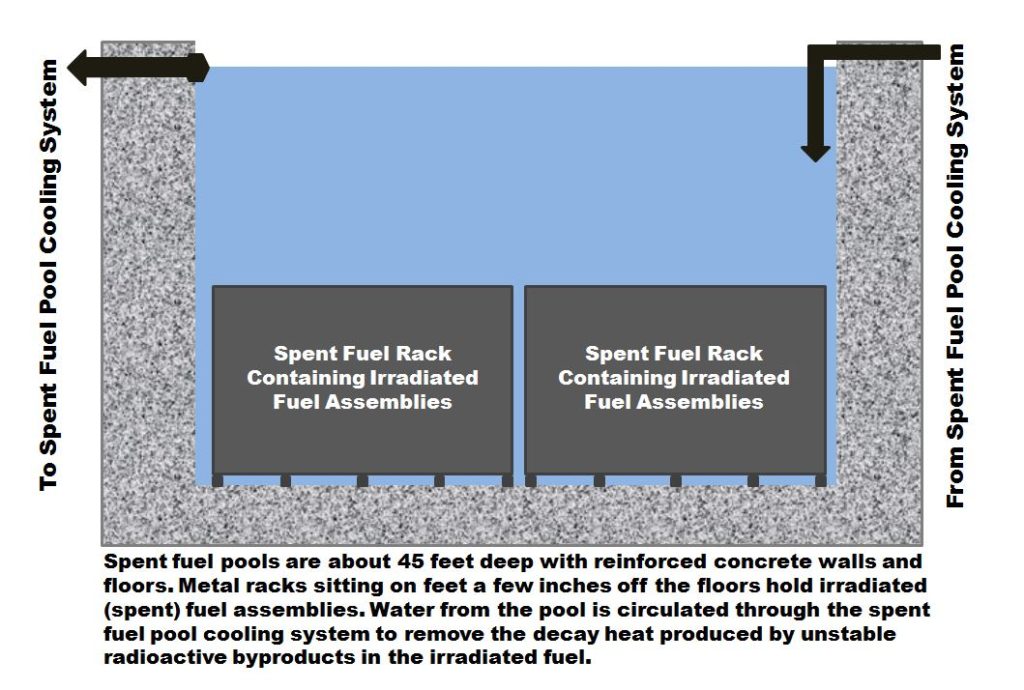
Fig. 1 (Source: UCS)
Like most in-ground swimming pools, spent fuel pools have openings—called scuppers—at the normal water level. Water enters the scuppers and flows into the spent fuel pool cooling system. This system cools the water before returning it to the spent fuel pool. To lessen the risk of accidentally draining water, the spent fuel pool’s walls and floor have no penetrations below the normal water level.
The decay heat emitted from spent fuel assemblies warms the water filling the racks. The warmed water rises due to convection. The rising warm water pulls in cooler water from beneath the racks to replace it (Fig. 2). This natural circulation flow cools the irradiated (spent) fuel assemblies.
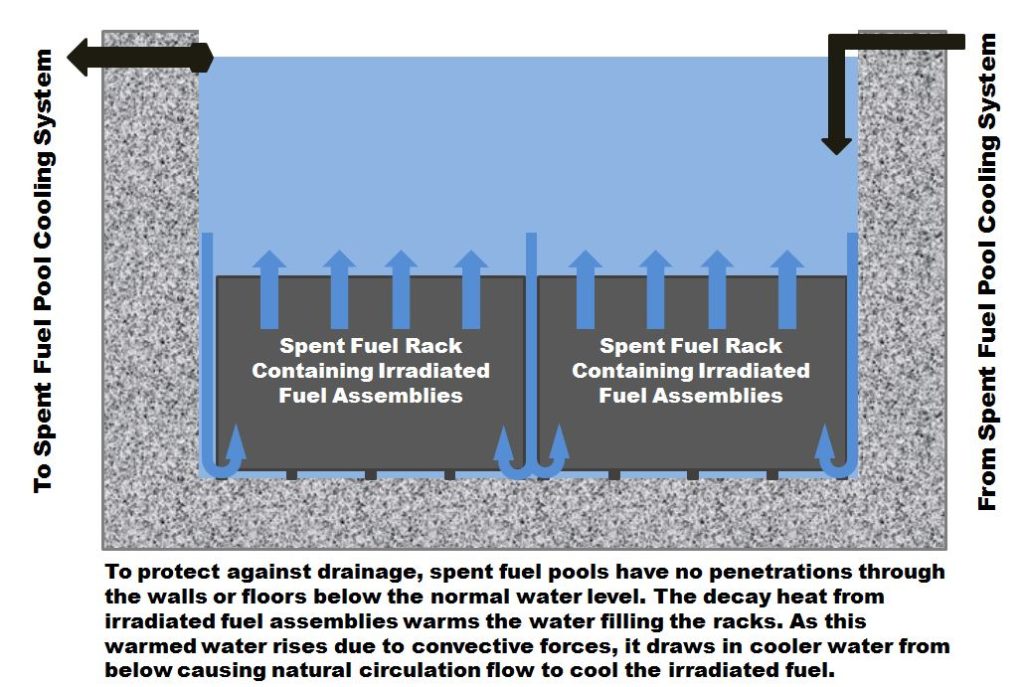
Fig. 2 (Source: UCS)
If the water were to rapidly drain from a spent fuel pool, the spent fuel pool cooling system obviously stops working. But the “chimney effect” takes over. The decay heat emitted from spent fuel assemblies warms the air filling the racks. The warmed air rises due to convection. The rising air pulls in cooler air from beneath the racks to replace it (Fig. 3). Studies performed by the NRC indicate that, except for irradiated fuel removed from an operating reactor core within the past two months, air cooling may be sufficient to protect the spent fuel from overheating.
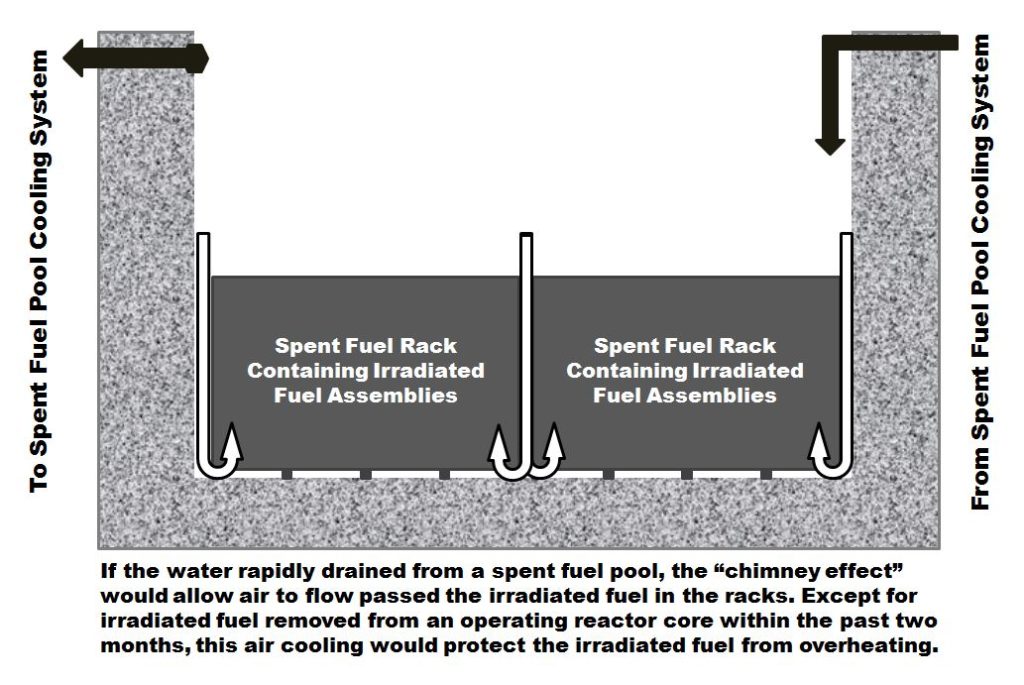
Fig. 3 (Source: UCS)
But what happens if a spent fuel pool only partially drains? The partial drainage disables the spent fuel pool cooling system and also blocks the “chimney effect” air flow (Fig. 4). The irradiated fuel assemblies may continue to be adequately cooled, even when the spent fuel pool water level drops below the top of the racks. The decay heat emitted from spent fuel assemblies heats water filling the racks to the boiling point. The steam vapor flowing past the exposed upper portions of the fuel assemblies can be enough to protect them from overheating.
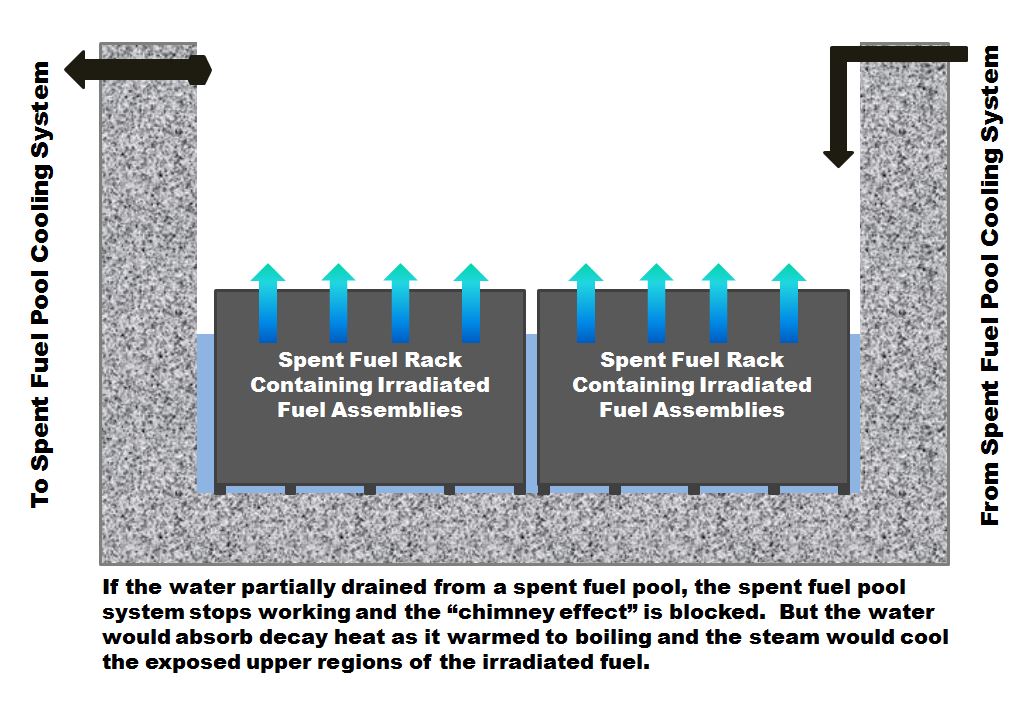
Fig. 4 (Source: UCS)
At some point, the water level in a partially drained spent fuel pool can drop low enough to prevent adequate cooling (Fig. 5). The decay heat emitted from the uncovered portion of the spent fuel assemblies is not carried away by the steam flowing past. Instead of getting removed, the heat increases the temperature of the metal rods containing the fuel pellets. Insufficient cooling can damage the spent fuel assemblies similar to how overheating damages fuel assemblies within the reactor core.
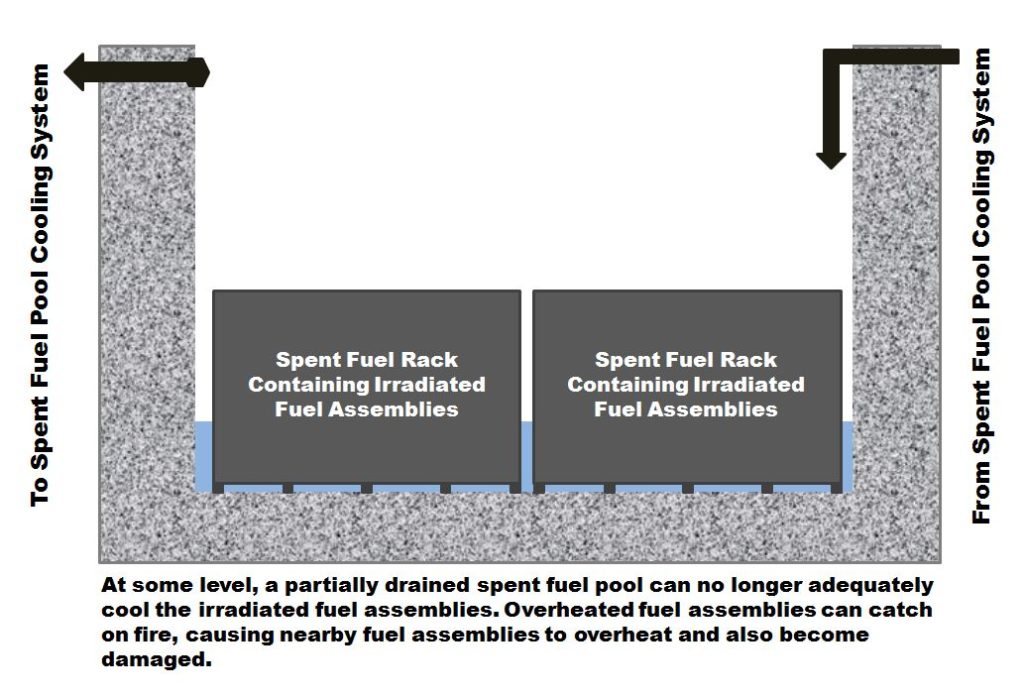
Fig. 5 (Source: UCS)
Safety by Intent
If inadequately cooled, irradiated fuel assemblies in spent fuel pools can be damaged similar to how irradiated fuel assemblies in reactor cores can be damaged by overheating.
There are differences between irradiated fuel in spent fuel pools and reactor cores. Some of the differences make spent fuel pool accidents less likely to occur than reactor core accidents. But some of the differences make the consequences from spent fuel pool accidents greater than from reactor core accidents.
When insufficient cooling water flows through a reactor core, workers have minutes to hours at most to restore adequate cooling before fuel damage occurs. When insufficient cooling flows through irradiated fuel assemblies in a spent fuel pool, workers have hours to days to restore adequate cooling. The longer time frame does not guarantee they can successfully intervene, but it certainly gives them a much higher chance of success.
On the other hand, the average spent fuel pool has about six times as many spent fuel assemblies as exists in the reactor core. Thus, a spent fuel pool accident could damage more irradiated fuel assemblies than can be damaged in a reactor core meltdown. And the spent fuel pool is located outside the thick containment walls, making it more likely that radioactivity released from damaged fuel escapes to the environment.
Which is preferable? A reactor core meltdown or a spent fuel pool accident?
It’s like debating whether it’s better to be poked in the left eye or the right eye.
—–
UCS’s Disaster by Design/Safety by Intent series of blog posts is intended to help readers understand how a seemingly unrelated assortment of minor problems can coalesce to cause disaster and how effective defense-in-depth can lessen both the number of pre-existing problems and the chances they team up.
